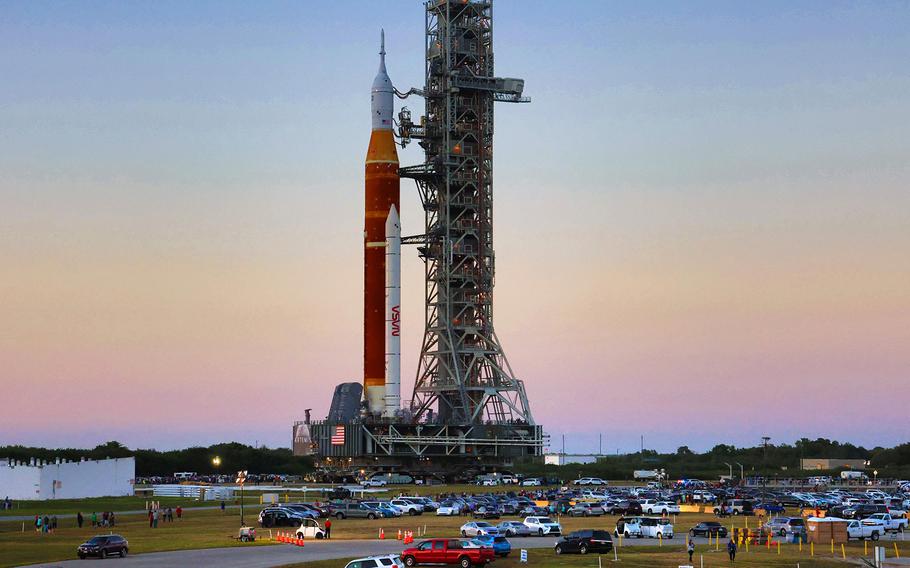
At Kennedy Space Center, Fla., NASA’s moon rocket for the Artemis 1 mission rolls to the launch pad, on March 17, 2022. (Joe Burbank/Orlando Sentinel/TNS)
ORLANDO, Fla. (Tribune News Service) — Kennedy Space Center will be juggling rockets and spacecraft in the next month that will herald a couple of new eras in space travel.
Both of KSC’s launch pads will be in action, one to send up two SpaceX Crew Dragon capsules while the other is performing a dress rehearsal for the Artemis I moon launch planned for later this year.
Days could shift, but at this point, NASA plans to simulate a countdown including the fueling and de-fueling of the Space Launch System rocket topped with the Orion capsule at Launch Pad 39-B from April 1-3.
Also targeting no earlier than April 3 is the launch of Axiom Space’s AX-1 flight, the first all-civilian crew to fly on a mission to the International Space Station.
Four “space participants,” including three that paid $55 million each for the opportunity along with a former astronaut now employed by Axiom Space, will be hitching a ride on SpaceX’s Crew Dragon Endeavour set to lift off on a Falcon 9 rocket from Launch Pad 39-A.
While Soyuz flights through the Russian space agency have brought civilians to the space station starting with Dennis Tito in 2001, this mission marks the first time they’ll come from a U.S.-based launch, and also the first time they have not been accompanied by a professional astronaut or cosmonaut. The crew includes paying customers Larry Connor, Mark Pathy and Eytan Stibbe along with commander Michael López-Alegría, a veteran of three space shuttle flights and a 215-day stint on the space station.
They plan to spend 10 days on board the ISS performing a bevy of scientific experiments and enjoying the view before returning home for a splashdown off the Florida coast.
That will make room for the next NASA crew rotation, also launching from 39-A in the newly dubbed Crew Dragon Freedom, named in deference to the Freedom 7 spacecraft flown by the first American in space, Alan Shepard.
“The name celebrates a fundamental human right, and the industry and innovation that emanate from the unencumbered human spirit,” said Crew-4 commander Kjell Lindgren in a post on Twitter. “Through the Commercial Crew Program, NASA and SpaceX have restored a national capability and we honor the ingenuity and hard work of those involved. Alan Shepard flew on Freedom 7 at the dawn of human spaceflight. We are honored to bring Freedom to a new generation.”
Lindgren, fellow NASA astronauts Robert Hines and Jessica Watkins and European Space Agency astronaut Samantha Cristoforetti of Italy are slated to launch no earlier than April 19 for Crew-4’s six-month long stay at the ISS as part of Expedition 67.
Their arrival will coincide with the return of Crew-3 on the Crew Dragon Endurance in which NASA astronauts Raja Chari, Thomas Marshburn and Kayla Barron along with ESA astronaut Matthias Maurer of Germany will complete the mission that took off from KSC last November. The exact day for splashdown has yet to be announced.
Before either SpaceX liftoff, though, NASA looks to get its launch pad activities out of the way for Artemis I, as managers said they would not tackle the filling and draining of the core stage with 730,000 gallons of super-cooled liquid hydrogen and liquid oxygen on the same day as a planned launch.
“We’ll stand down from activities during the launch window,” said Mike Bolger, NASA’s Exploration Ground Systems program manager based at KSC. “We really don’t have any significant impact. You know the pads are about a mile apart, and so really the only time that we have any kind of hazard from one pad to the other is actually during the launch window.”
The 5.75 million-pound, 322-foot-tall combination of the Space Launch System, Orion capsule and mobile launcher arrived to 39-B on March 18 after an 11-hour trip from the Vehicle Assembly Building. Teams have since connected ground support equipment elements such as electrical, fuel environmental control system ducts and cryogenic propellant lines, powering up all elements of the vehicle for the first time on Monday.
If all goes well, the Artemis I rocket will go through the tests and not roll back to the VAB for another eight or nine days, so it should be on the pad at the same time as the AX-1 launch, but back to the VAB before Crew-4.
It won’t return to the launch pad until mission managers go through the test results, but the next possible windows for the Artemis I launch are from May 7-21, June 6-16 and June 29-July 12.
NASA Administrator Bill Nelson said that even if all goes well, June was the more likely target.
____
©2022 Orlando Sentinel.
Visit at orlandosentinel.com.
Distributed by Tribune Content Agency, LLC.